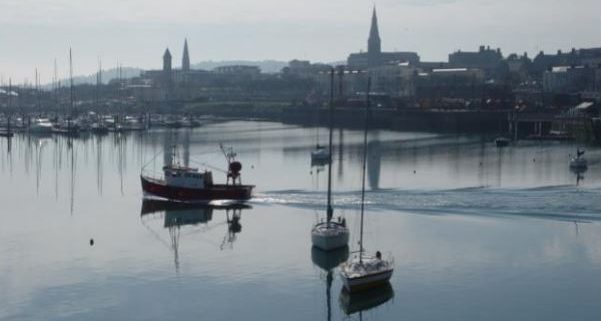
” The Beckett Country “
A celebration of one of the most unique literary landscapes in the world. First broadcast on RTE Radio 1’s Sunday Miscellany in April 2006 on the occasion of the centenary of Samuel Beckett’s birth. This was subsequently published in Sunday Miscellany, a selection from 2004-2006, ed. by Cliodhna Ní Anluain, published by New Island, 2006.
I can’t claim to be a literary aficionado. In fact I got a middle C in honours leaving cert English –twice – and my first serious book purchase only came was when I was 18 after winning £37 in a late night poker session. The next day the coins strewn across the counter of a Dún Laoghaire bookshop as I clutched my trawl of paperbacks.
The interest I developed in literature comes partly from my mother, friends and teachers. But I also think it comes from the fact that I live in what is possibly the most literary counties in Ireland. Dún Laoghaire-Rathdown, a makey-uppy county created in 1994 out of the break up of the old Dublin County Council and Dún Laoghaire borough, is not one that rolls off the literary tongue. But it is a unique literary landscape.
A quick tour will give you some idea. Looking north to Booterstown, Blackrock and Monkstown there is Frank McGuinnes and the Marsh, grenades thrown by Paul Carson in Blackrock, the Quiet Man Maurice Walsh, the house where Flan O’Brien wrote At Swim Two Birds. Looking inland there is Leo Cullen, Gerald Dawe, Marian Keyes, Julie Parsons, Sarah Webb, Marita Conlon McKenna, Nuala ní Dhomnaill, Martina Devlin, Eamon Delaney, Liam O’Muirthile and so many more. Walk south past the Mariner’s Church where the Grandfather of another local writer Julie Parsons was once Canon. Then to the Mecca of Irish literature, Joyce’s Tower in Sandycove, inland a few paces to where LAG Strong spent glorious summers, then a short hop to where Hugo Hamilton, the Speckled boy, grew up, and where Joseph O’Connor grew up, often passing the Speckled boy. Up the hill past Fitzgerald’s pub, passing the road where Denis Johnston lived, another where Synge lived, to Monk Gibbon. To Dalkey for the second chapter of Ulysses, and where Hugh Leonard was Home Before Night and Out after Dark, where Flann O’Brien proposed his molleycule theory of bicycles and police, where George Bernard Shaw lived part of his childhood, then to Killiney and Paul Murray’s Evening of Long Goodbyes and down to Deansgrange and Clonkeen road where Colum McCann was born and raised. A unique literary landscape all in an afternoon’s walk.
At the top of Clonkeen Road, you could continue another mile up Cornelscourt hill from Cabinteely to Cooldrinagh, the home of Samuel Beckett.
But what had Beckett to do with these surroundings? There is little to root him in a geographical reality. He was a man of ideas who, at times, would not even let his actors move on stage.
A closer reading of Beckett’s work reveals the remarkable influence of this part of Dublin in particular. It occupies a paramount role in what Eoin O’Brien has called
‘the Beckett Country’. As Beckett revealed late in his life ‘the old haunts were never more present’ and ‘I walk those backroads with closed eyes’.
A significant landmark used by Beckett to evoke an experience at Greystones Harbour that would change the direction of his writing is Dún Laoghaire’s East Pier. There Beckett recounts in Krapp’s Last Tape the struggle to establish himself as a writer and where, one spring equinox, came the revelation, ‘suddenly I saw the whole thing’ that Beckett would use himself as his own literary subject.
Malone Dies reaches its macabre climax when a party of lunatics take a boat trip to Dalkey Island.
The events in All That Fall occur on the day of a race meeting in Leopardstown racecourse with much of the action taking place in Foxrock train station (known as Boghill station in the book).
Although he was careful not to pinpoint a precise location for Waiting for Godot, the often bleak and windswept landscape he encountered on his walks in the Dublin mountains must have been inspirational mood setting for it.
In another Ballyogan, now best known as a landfill site and recycling facility, features;
Nowhere in particular on the way form A to Z. Or say for versimilitude the Ballyogan Road. The dear old back road. Somewhere on the Ballyogan Road in lieu of nowhere in particular…
This always comes to mind when I go recycling.
The quarries at Glencullen and Barnacullia are remembered in First Love.
Beckett tramped the hills, fields and lanes of the Dublin Mountains with his father.
They would climb the Glencullen road.
The first thing they had to do of course when they got to the top was to admire the view, with special reference to Dún Laoghaire, framed to perfection in the shoulders of Three Rock and Kilmashogue, the long arms of the harbour like an entreaty in the blue sea.
It is just a few miles from these peaks to the coast of Dún Laoghaire-Rathdown. Surely there can’t be any area more densely populated with writers, their memories and works than these.





